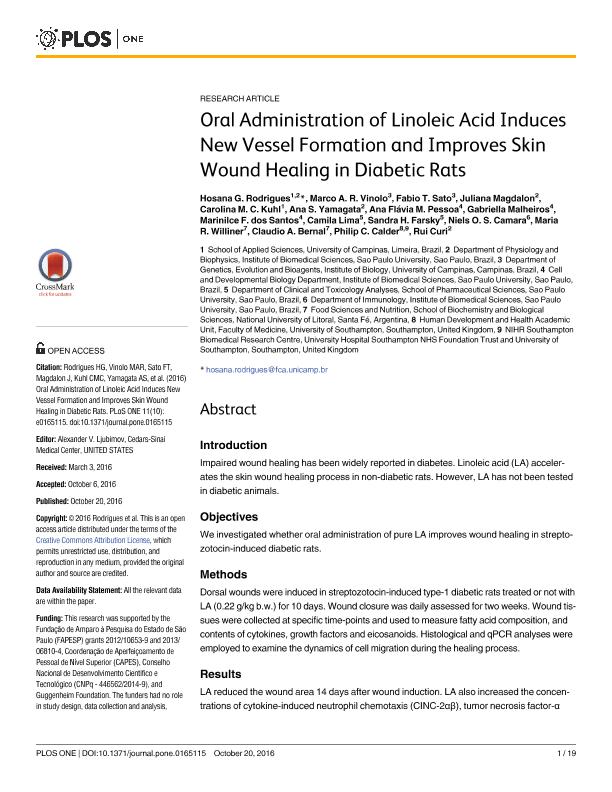Artículo
Oral administration of Linoleic acid induces new vessel formation and improves skin wound healing in diabetic rats
Rodrigues, Hosana G.; Vinolo, Marco A. R.; Sato, Fabio T.; Magdalon, Juliana; Kuhl, Carolina M. C.; Yamagata, Ana S.; Pessoa, Ana Flávia M.; Malheiros, Gabriella; Dos Santos, Marinilce F.; Lima, Camila; Farsky, Sandra H.; Camara, Niels O. S.; Williner, María Rosa; Bernal, Claudio Adrian ; Calder, Philip C.; Curi, Rui
; Calder, Philip C.; Curi, Rui
 ; Calder, Philip C.; Curi, Rui
; Calder, Philip C.; Curi, Rui
Fecha de publicación:
10/2016
Editorial:
Public Library of Science
Revista:
Plos One
ISSN:
1932-6203
Idioma:
Inglés
Tipo de recurso:
Artículo publicado
Clasificación temática:
Resumen
Introduction: Impaired wound healing has been widely reported in diabetes. Linoleic acid (LA) accelerates the skin wound healing process in non-diabetic rats. However, LA has not been tested in diabetic animals. Objectives: We investigated whether oral administration of pure LA improves wound healing in streptozotocin- induced diabetic rats. Methods: Dorsal wounds were induced in streptozotocin-induced type-1 diabetic rats treated or not with LA (0.22 g/kg b.w.) for 10 days. Wound closure was daily assessed for two weeks. Wound tissues were collected at specific time-points and used to measure fatty acid composition, and contents of cytokines, growth factors and eicosanoids. Histological and qPCR analyses were employed to examine the dynamics of cell migration during the healing process. Results: LA reduced the wound area 14 days after wound induction. LA also increased the concentrations of cytokine-induced neutrophil chemotaxis (CINC-2αβ), tumor necrosis factor-α (TNF-α) and leukotriene B4 (LTB4), and reduced the expression of macrophage chemoattractant protein-1 (MCP-1) and macrophage inflammatory protein-1 (MIP-1). These results together with the histological analysis, which showed accumulation of leukocytes in the wound early in the healing process, indicate that LA brought forward the inflammatory phase and improved wound healing in diabetic rats. Angiogenesis was induced by LA through elevation in tissue content of key mediators of this process: vascular-endothelial growth factor (VEGF) and angiopoietin-2 (ANGPT-2).
Palabras clave:
Oral Administration of Linoleic Acid
,
Skin Wound Healing
,
Diabetic Rats
Archivos asociados
Licencia
Identificadores
Colecciones
Articulos(CCT - SANTA FE)
Articulos de CTRO.CIENTIFICO TECNOL.CONICET - SANTA FE
Articulos de CTRO.CIENTIFICO TECNOL.CONICET - SANTA FE
Citación
Rodrigues, Hosana G.; Vinolo, Marco A. R.; Sato, Fabio T.; Magdalon, Juliana; Kuhl, Carolina M. C.; et al.; Oral administration of Linoleic acid induces new vessel formation and improves skin wound healing in diabetic rats; Public Library of Science; Plos One; 11; 10; 10-2016; 1-19; e0165115
Compartir
Altmétricas



